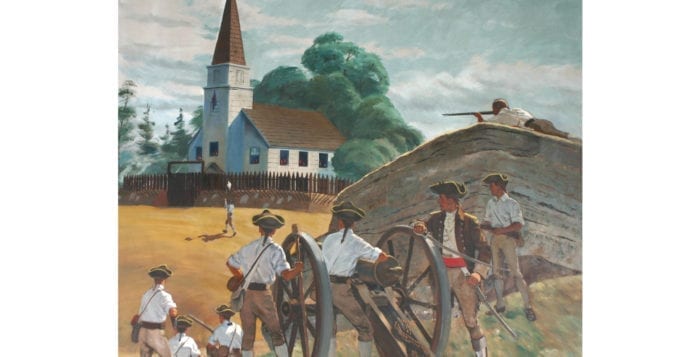Loyalists overtake the Setauket Presbyterian Church

By Beverly C. Tyler
Early in 1777, Queens County Loyalist troops, under the command of Loyalist Lieutenant Colonel Richard Hewlett, took possession of the Setauket Presbyterian Church. They turned the church into a barrack and fortified the area around the building with an earthwork topped with sharpened wooden poles. They placed bundles of branches along the top of the fortification as protection from musket fire and more sharpened poles facing outward along the earthwork to repel a frontal attack. They also set swivel guns in the window openings to fire down on attackers. The resultant fort in the middle of the small settlement of Setauket was then ready to provide protection and safety for the small force of Tory troops.
The stationing of troops in Setauket was part of a British plan to provide a series of observation points on Long Island, which would keep an eye peeled for any movement of rebel troops from Connecticut that might threaten British positions on Long Island and in New York City.
On Aug. 16, 1777, Brigadier General Samuel Parsons was ordered by General Israel Putnam, to gather Continental Army troops in Connecticut, procure boats, “and such small armed or other vessels as you find necessary and proper … You are to make a descent on Long Island and deplete and destroy such parties of the enemy as are found at Huntington and Setauket.”
Parsons, born in Lyme Connecticut in 1737 and educated at Harvard, was by 1777 a veteran of two major battles. As an effective strategist under General George Washington, Parsons was familiar with the conditions on Long Island and with the plight of both the refugees who fled to Connecticut and the Americans who remained on Long Island under the rule of the British military governor.
On Aug. 21, the day before his troops were to attack the Loyalists at Setauket, Parsons issued the following order. “On the present expedition … ‘tis not to distress the helpless women or honest citizen we draw our swords, but from the noble and generous principle of maintaining the right of humanity and vindicating the liberties of freemen. The officers and soldiers are therefore most earnestly exhorted and strictly commanded to forbear all violation of personal property; not the least article is to be taken but by orders; we are to convince our enemies we despise their practices and scorn to follow their example. But should any person be so lost to all virtue and honor as to infringe this order, he or they may depend on the most exemplary punishment … and the greatest silence on the march is to be observed.”
“On the present expedition … ‘tis not to distress the helpless women or honest citizen we draw our swords.”
—General Samuel Parsons
The expedition left Fairfield Harbor that night under cover of darkness. Parsons knew that the success of the mission depended on surprise. Care was taken to avoid detection, but it was to no avail. The force was spotted from shore as it crossed the Sound and landed at Crane Neck Bend early in the morning.
The alarm was quickly spread and the Loyalist officers and men assembled at the fort. Hewlett was staying at the home of Benjamin Floyd. He arrived at the fort just ahead of the Americans. The element of surprise was gone and with it any chance of capturing the fort.
Parsons set up his cannon behind the large rock on what was then part of the Village Green. He sent a message to Hewlett demanding the surrender of the fort. Hewlett asked for a half hour to consult with his officers. Parsons said he would give them ten minutes. The reply came back, “Colonel Hewlett’s compliments to General Parsons, and is determined to defend the fort while he has a man left.”
The artillery officer was Continental Army Lieutenant Caleb Brewster, a refugee from Setauket. Parsons knew that a frontal attack would be suicide so he attempted to breach the walls of the fort with cannon fire. The two sides fired at each other for about four hours with little effect. Then Parsons, fearing that British warships on the Sound would cut off his return route to Connecticut, broke off the attack and headed back to the vessels at Crane Neck. The Patriot troops took with them some horses, blankets and other supplies belonging to the loyalists.
The attack had failed to accomplish its primary purpose, but the residents in Setauket now knew that Washington and the Continental Army had not forgotten the plight of the Patriots in enemy territory on Long Island. However, this is not the end of the story, which continues next with Hewlett, Parsons, Brewster and the Culper Spy Ring.
Beverly C. Tyler is Three Village Historical Society historian and author of books available from the society at 93 North Country Road, Setauket. For more information, call 631-751-3730 or visit www.tvhs.org.






